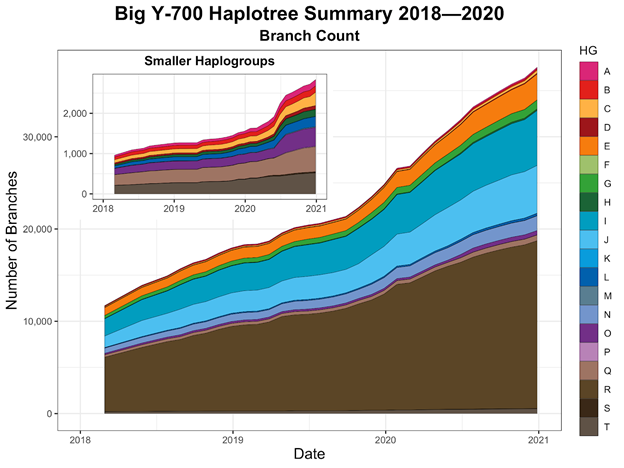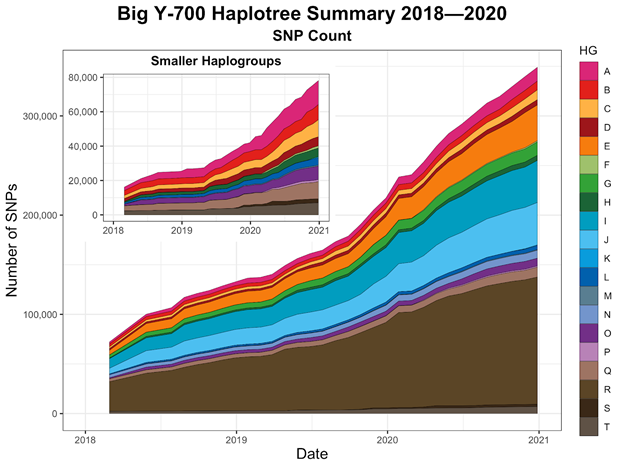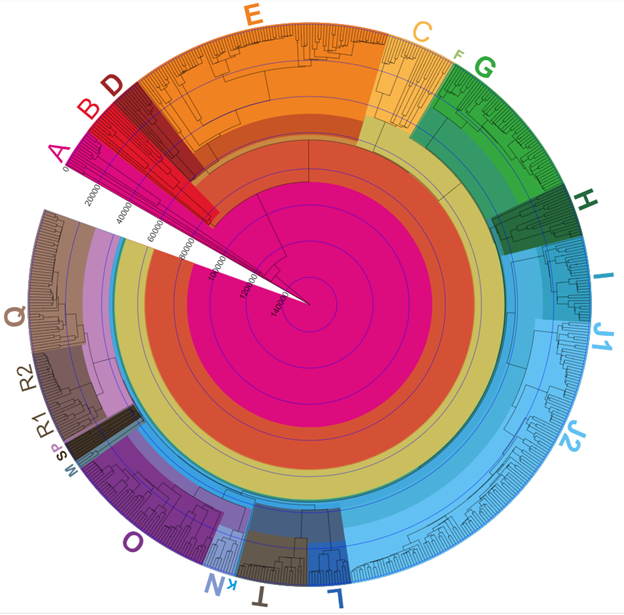A Summary Of 2020
2020 was a year that many of us are happy to put behind us. Gene by Gene redirected some resources to building a COVID testing lab and many employees found themselves working from home rather than the office. We adapted, added capacity, the lab kept running, and produced high-quality results.
FamilyTreeDNA’s phylogenetic specialist Michael Sager has been expanding the great tree of mankind at an unprecedented rate.
2020 was a great year for Y-DNA testing. FamilyTreeDNA added another 15,000 new high-coverage Big Y results to the Haplotree analysis, almost 5,000 academic results from present-day men in addition to thousands of ancient DNA results. This resulted in the addition of over 12,500 branches to The Great Tree of Mankind. Over 200,000 new unique SNPs were discovered.


The Great Tree of Mankind
The Great Tree of Mankind, or the Haplotree, is a large study of the genetic history of all human male lineages. Men inherit their Y chromosomes from their father, who inherited it from their father, and so on. Unlike most other DNA that we inherit from our parents, the Y chromosome does not mix or recombine, but only accumulates a few mutations over time. This allows us to study the direct paternal lineages in great resolution, going back thousands, tens of thousands, and even hundreds of thousands of years.
Every DNA tested Y chromosome of present-day men from across the whole world can be traced back to a single male ancestor who lived some 235,000 years ago, most likely in West Africa. We do not know much about this man, commonly referred to as “Y-Adam”, other than that he had some sons who had some sons and grandsons. Eventually, their direct male descendants spread out over the world and have descendants who became ancestors of large groups of men. We refer to these anonymous men, who left their genetic imprint in all present-day men, by base haplogroup letters from A through T.
The Big Y test is a high-resolution NGS (next-generation sequencing) test that targets the Y chromosome to great depth and detects small mutations that differ between individuals. These small mutations can be used to construct a high-resolution family tree of mankind, without knowing anything about anyone’s genealogy. Mutations, or SNPs (“snips”), happen on average every few generations and can be translated into genetic progenitors who left a genetic imprint that can serve as a marker for all descendants.
Genealogy Applications
- Discover your Family Clade and its placement on the great tree of mankind
- Find out how groups of people with the same or different surnames are related
- Pinpoint the ancestor who gave rise to a specific genetic marker and use it to identify other descendants
- Estimate when the most recent common ancestor with your matches lived
Match Database
It is often said that genetic genealogy is a team sport, and that is definitely also true for high-resolution Y-DNA testing. What good is having your Y chromosome sequence if you can’t compare it to anyone? FamilyTreeDNA has the largest and most comprehensive database of its kind, with over half a million Y-DNA testers and over 52,000 high coverage Y-DNA sequences from Big Y testers.
Some customers take a Big Y test and discover that they have many male relatives within the genealogical timeframe that they can use as clues to the origins of their paternal line or surname.
Other results are exciting in a different way; one customer’s Big Y result from 2020 came back with no matches within 45,000 years, meaning that his unique lineage survived for all of those years, from relatively shortly after the Out of Africa expansion, but that all present-day descendants had eluded DNA testing studies up until now. (The man was from Indonesia and we could later find a paternal line relative from Malaysia)
You never know what you are going to find!
Academic Studies
In order to make the Big Y database more comprehensive and interesting for customers of all different backgrounds, we added almost 5,000 Y chromosomes from present-day males that have participated in academic NGS studies. This includes the 1000 Genomes Project, Human Genome Diversity Project (HGDP), Simons Genome Diversity Project (SGDP), and about 75 other studies. This has resulted in a big boost in branch refinement for many parts of the Haplotree with fewer customers.
Ancient DNA
In recent years Ancient DNA has come up as a great source of information about the history of mankind, with hundreds of studies publishing genetic data from archeological remains from all over there world. Michael Sager also found the time between keeping the Haplotree up to date with new customer and academic results to incorporate thousands of low to high coverage Y chromosome results from ancient remains from over a hundred different studies. This has resulted in many interesting connections between the past and the present that we look forward to sharing with the users.
Age Estimates
We are hard at work preparing to introduce one of the most anticipated features for the Big Y product! Age estimates will revolutionize the haplotree by putting its branches into a more genealogical context.
Our current haplotree uses SNPs to decide the branching structure, but the branch lengths do not directly correspond to time. There is a loose association between mutations and time (known as a molecular clock), but the ticks of the clock do not always occur in even intervals. Our “time tree” will take into account many considerations to provide accurate age estimates for the largest Y-chromosome haplotree in existence!
A sneak preview of the time tree is shown below. Adjacent to each major clade is the number of downstream branches as of December 31, 2020. Our most populous clades have large numbers of testers with common ancestors who lived less than 5,000 years ago. In order to evenly display the main structure of the tree, we have collapsed these more recent branches. Since Haplogroup R has about half of our total branches, we also show that clade separately, with branches younger than 2,000 years ago collapsed.
Autosomal ancestry at the continental level is averaged for each branch to highlight major ethnic patterns in the tree.

Certain patterns are clear. For example, 33% of the entire Y-chromosome timeline included just two branches: A00 and A0-T. Certain major clades are also overwhelmingly prevalent in one continental region, such as Haplogroup I in Europe, or Haplogroups MS and parts of C1 in Oceania, or D1 and O in East Asia. Below, we show another view of the tree without A00, to highlight more recent evolution in the tree.

What’s Next?
We have many exciting new Y-DNA features planned for this year!
- Ancient & Academic samples – Who are you related to?
- Age estimates for the Haplotree – When did your most recent common ancestor with your matches live?
- Family Finder Haplogroups – Which autosomal matches could share your paternal line?
How can you participate?
If you are a male, you can get a Big Y test for yourself or a male relative. And don’t forget that your mom’s father had a Y chromosome that can also help you with your genealogy!
If you are female, you can ask a brother, uncle, or male cousin to test.
